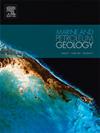Origin of reedmergnerite in sodium carbonate successions and environmental implications in a Late Paleozoic alkaline saline lake, NW Junggar Basin, China
IF 3.6
2区 地球科学
Q1 GEOSCIENCES, MULTIDISCIPLINARY
引用次数: 0
Abstract
The Fengcheng Formation originated from a Late Paleozoic alkaline saline lake, characterized by abundant evaporites and serving as the primary source rocks within this evaporitic basin. Boron accumulation in this set of evaporitic deposits is primarily in the form of reedmergnerite (NaBSi3O8). Although reedmergnerite can be found in each sub-environment of this alkaline saline lake, it may dominate in evaporite successions near the evapocenter. However, its distribution pattern and origins within the evaporite succession remain unclear. Through comprehensive analyses of a reedmergnerite-rich evaporite core section, we propose the following: (1) boron originates from volcanic ash and hot spring; (2) diagenetic processes within a hydrothermal environment involve replacement of sodium carbonates by loughlinite (Na2Mg3Si6O16▪8H2O) fibers followed by crystallization of reedmernerite within loughlinite during contemporaneous diagenesis; (3) vertical distributions of reedmergnerite within evaporitic successions are controlled by episodic volcanic eruptions, hot spring ejections, and climatic cycles; and finally, (4) significant volumes of reedmergnerite occur within sodium carbonate successions due to multiple stages of volcanic eruptions and hot spring ejections. Therefore, the boron accumulations within the sodium carbonate successions in the Fengcheng Formation provide compelling evidence of deep sources contributing to the formation of chemical deposits in an alkaline saline lake environment. The accumulation of reedmergnerite can be regarded as a boron resource that formed specifically within this type of alkaline saline lake setting. Furthermore, the presence of laminated reedmergnerite and louglinite can serve as indicators for identifying episodic volcanic activities and hot spring occurrences, thereby providing a basis for assessing the environmental conditions during source rock formation in an evaporitic basin.

准噶尔盆地西北部晚古生代碱性盐湖碳酸钠层序中芦苇美沙石的成因及其环境意义
丰城组发源于晚古生代碱性盐湖,蒸发岩丰富,是该蒸发盆地的主要烃源岩。在这套蒸发矿床中,硼主要以芦苇合并辉石(NaBSi3O8)的形式富集。芦苇美沙石在盐湖各亚环境中均有分布,但在靠近蒸发中心的蒸发岩序列中占主导地位。但其在蒸发岩演替中的分布格局和成因尚不清楚。通过对某富芦苇美沙岩蒸发岩岩心剖面的综合分析,提出:(1)硼来源于火山灰和温泉;(2)热液环境下的成岩过程包括:同生成岩过程中,高岭石(Na2Mg3Si6O16 - 8H2O)纤维取代碳酸钠,然后在高岭石内部形成芦苇角银石结晶;(3)芦苇美沙石的垂直分布受幕式火山喷发、温泉喷发和气候周期的控制;(4)由于多期火山喷发和温泉喷发,在碳酸钠层序中存在大量芦苇美沙石。因此,丰城组碳酸钠层序中的硼聚集为碱性盐湖环境下化学矿床的形成提供了强有力的证据。芦苇美沙石的富集可以看作是在这种碱性盐湖环境中形成的一种硼资源。此外,层状芦苇美砂岩和滑石的存在可以作为识别幕式火山活动和温泉产状的指标,从而为评价蒸发盆地烃源岩形成时的环境条件提供依据。
本文章由计算机程序翻译,如有差异,请以英文原文为准。
求助全文
约1分钟内获得全文
求助全文
来源期刊

Marine and Petroleum Geology
地学-地球科学综合
CiteScore
8.80
自引率
14.30%
发文量
475
审稿时长
63 days
期刊介绍:
Marine and Petroleum Geology is the pre-eminent international forum for the exchange of multidisciplinary concepts, interpretations and techniques for all concerned with marine and petroleum geology in industry, government and academia. Rapid bimonthly publication allows early communications of papers or short communications to the geoscience community.
Marine and Petroleum Geology is essential reading for geologists, geophysicists and explorationists in industry, government and academia working in the following areas: marine geology; basin analysis and evaluation; organic geochemistry; reserve/resource estimation; seismic stratigraphy; thermal models of basic evolution; sedimentary geology; continental margins; geophysical interpretation; structural geology/tectonics; formation evaluation techniques; well logging.
 求助内容:
求助内容: 应助结果提醒方式:
应助结果提醒方式:


